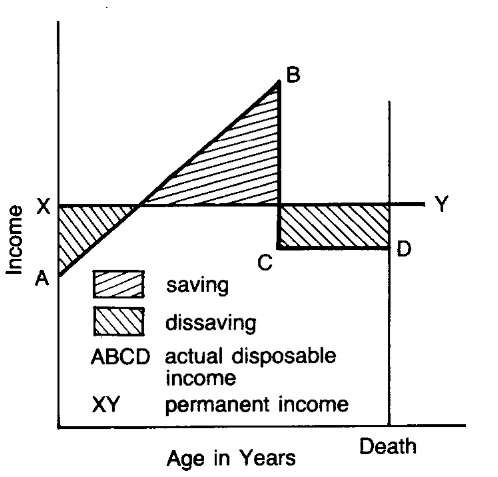The Life Cycle Hypothesis (LCH) of Consumption; its model, explanation and criticisms
The Life-Cycle hypothesis or LCH model is an extension to the two period consumption model. The LCH model defines individual behaviour as an attempt to smooth out consumption pattern over one’s life time somewhat independent of current levels of income. The model divides an Individuals pattern of Consumption, Income, and Savings into three stages which are;
- Early life
- Mid life
- Old age/Retirement age
It is given diagrammatically as;

This model states that early in one’s life, consumption expenditure may very well exceed income as the individual may be making major purchases related to buying a new home, and beginning a career. At this stage in life, the individual will borrow from the future to support these expenditure needs.
In mid-life however, these expenditure patterns begin to level off and are supported or perhaps exceeded by increases in income. At this stage, the individual repays any past borrowings and begins to save for his/her retirement.
Upon retirement, consumption expenditure may begin to decline however income usually declines dramatically. In this stage of life, the individual dis-saves or lives off past savings until his death.
In the first stage of the life-cycle, the individual will borrow based on expected levels of wealth and income in the future. This wealth is defined as human wealth-the individual’s ability to generate or earn income in the future (based on anticipated skills, talents, and initiative) in addition to non-human wealth-ownership of income producing assets. The desire to borrow from one’s future will depend on the faith the individual has about his or her ability to repay these debts and to the degree to which an individual discounts future activity.
Specifically, a greater faith in the future earning power is consistent with a lower rate of time preference (where the individual discounts the future less and relates future activity to be almost as important as current activity).
Therefore, less faith in future earning power results in higher rates of time preference and a greater discounting of future activity. In this second case, current consumption depends heavily on current income.
The Life-Cycle Hypothesis (LCH)is based on the following model:
max Ut = ΣL[U(Ct)(1+δ)-t] —–“maximize the utility from consumption over time”
so that,
ΣLCt(1+r)-t = ΣNYt(1+r)-t + Wo ——- “lifetime consumption must equal income”
Where,
U(Ct) is the satisfaction received from consumption in time period ‘t’,
Ct is the level of consumption,
Yt is income
‘δ’ is the rate of time preference ( a measure of individual preference between present and future activity) and,
Wo is an initial level of income producing assets.
Criticism of the Life Cycle Hypothesis;
1.There is basically no difference between the LCH model and the Permanent Income model – the LCH model is believed and said by some people to be “Permanent Income with a different name”.